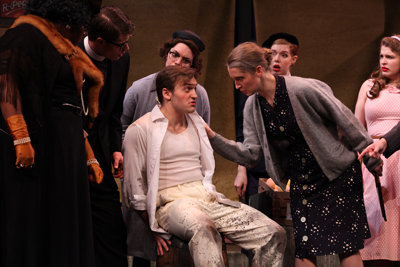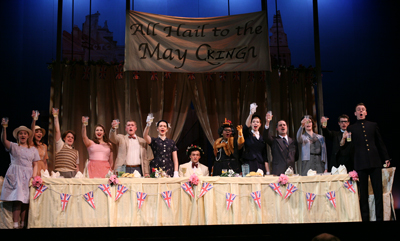by Daniel Hathaway

Populated with characters who might have stepped right out of Miss Marple’s village of St. Mary Mead, Britten’s three-acter was adapted from a story by Guy de Maupassant and translated from France to Suffolk.
The village is in a tizzy because no candidates for May Queen measure up to the formidable Lady Billow’s exacting moral standards. As a compromise, the village committee decides to switch to a May King and nominates Albert Herring, son of a widowed greengrocer whose apron strings have kept him so tightly bound that he’s oblivious of temptation. All goes well until Sid, the butcher’s assistant and his squeeze Nancy contrive to spike Albert’s lemonade at the May banquet. Still tipsy and suddenly envious of the exploits of others, Albert uses some of his May King prize money to go on a bender and eventually has the whole village out searching for him — and mourning his death when his tattered floral crown turns up. He finally comes home, but unlike the prodigal son, gets an earful rather than the fatted calf from Mum and the villagers.
Sunday’s performance (the show was largely double-cast) was rich in vocal and acting talent. Amber Monroe was a commanding Lady Billows — one of those she-who-must-be-obeyed figures — and as Albert, Joshua Blue was splendid both in voice and carriage. Kayleigh Decker played the emasculating Mrs. Herring with mousy conviction, and Aubrey Ballaro-Hagadorn (Miss Wordsworth) and Micaëla Aldridge (Florence Pike) were strong in supporting roles. Daveed Buzaglo made an appropriately sleazy Sid and Hannah Hagerty an attractive Nancy — who didn’t deserve him.
The rest of the stock village characters — Mayor Upfold (Carlos Enrique Santelli), Gedge, the Vicar (Adam Wells) and the constable, Supt. Budd (Eric Fischer) — seemed tailor-made for their roles. As Emmie, Cis and Harry in all four shows, Rachel Rossello, Elise Volkmann and Vanessa Croome made fine village urchins.
Every major character got the opportunity to sing an extended aria, and that’s where their individual vocal prowess really blossomed. Britten’s imaginative and colorful orchestration was masterfully handled by conductor Christopher Larkin and a superb band of twelve musicians (Larkin doubled on piano).
Set designer Christopher McCollum, lighting designer Jeremy K. Benjamin and costume designer Chris Flaharty produced a colorful period ambiance.
Jonathon Field’s canny stage direction inspired some wonderfully natural acting from his singers. There’s always one signature Field gesture involved, of course. This one came in a sudden pose by the thirteen guests as the banqueting table —which explained the nod to Leonardo da Vinci in the credits.
The production values of shows that Oberlin Opera Theater produces twice a year continue to amaze and delight. Albert Herring may even have raised the bar a bit higher.
Photos by John Seyfried (not necessarily of singers named in this review.)
Published on ClevelandClassical.com March 18, 2014
Click here for a printable version of this article.




